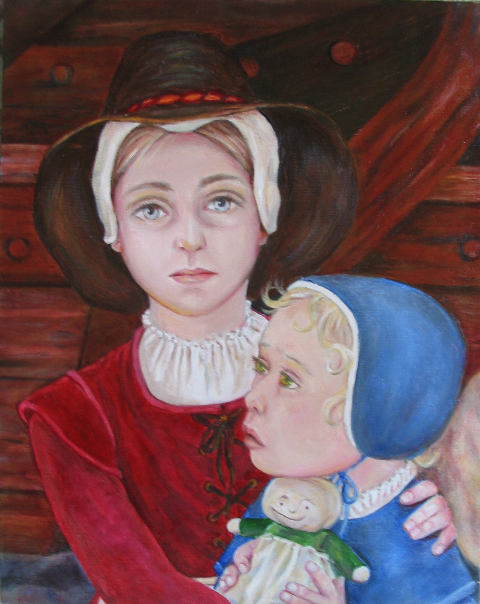The story of the four More children, Ellen, Jasper, Richard, and Mary, is a tragic one. They were all baptized in the parish of Shipton, Shropshire, England to Samuel and Katherine More, cousins from a wealthy and prominent family that had had their marriage prearranged. It was not a happy marriage, and Katherine had a longstanding but secret extramarital affair with a neighbor by the name of Jacob Blakeway. Samuel began working in London as secretary to Lord Edward Zouche, privy councillor, diplomat and courtier. Over the next four years, Katherine bore four children. At some point, Samuel More began to notice a resemblance between "his" children, and Jacob Blakeway whom he had come to suspect was with his wife. When he realized his four children were not actually "his", but were bastards, he and his wife engaged in a bitter divorce in 1616 and Samuel ended up getting custody of the children he claimed were not his. By a deed dated 20 April 1616, Samuel cut the entail on the Larden estate to prevent any of the children from inheriting. During the long court battle, Samuel would deny that he was the father of the children borne by his wife, Katherine, and stated them to be children of the adulterous relationship. Katherine did not deny her relationship with Jacob, stating there was a former betrothal contract with him, and therefore he was her true husband. This would have made her marriage to Samuel invalid. Samuel quotes her words in his declaration, "though she could not sufficiently prove by witnesses yet it was all one before god as she sayed".
In 1616, when Samuel More accused his wife of adultery and, at the direction of his father, Richard, they devised a plan to rid himself of Katherine and the children. Samuel went to his employer and a More family friend, Lord Zouche, Lord President of the Council of Wales, Lord Warden of the Cinque Ports and Privy Counselor, to draw up a plan for the disposition of the children. Zouche had been a member of the Virginia Company and in 1617 he invested £100 in an expedition to the Colony of Virginia, which is where the Mayflower was supposed to have landed. It was his actions that were instrumental in putting the More children on the Mayflower. (At that time, children were routinely rounded up from the streets of London or taken from poor families receiving church relief to be used as labourers in the colonies.) Katherine engaged in a struggle to take her children back. Any legal objections to the involuntary transportation of the children were over-ridden by the Privy Council, namely, Lord Zouche. There were at least twelve actions recorded between December 1619 and 8 July 1620, when it was finally dismissed. Most people thought it a death sentence and, indeed, many did not survive either the voyage or the harsh climate, disease and scarcity of fresh food for which they were ill-prepared.
Samuel promptly paid for the children to be shipped off to America with a band of "honest and religious" Separatists. The four children, aged 4 to 8 years old, were placed into the households of some of the most prominent Pilgrims. Richard and Mary More were placed with Elder William Brewster. Jasper was placed with Governor John Carver. And Ellen was placed with Edward Winslow. Within several weeks of the More children’s arrival in London, and without their mother Katherine More’s knowledge or approval, they were placed in the care of others on the Mayflower, bound for New England.
After the Mayflower sailed, Katherine made another attempt to challenge the decision through the courts. It was this legal action in early 1622 before Chief Justice James Ley which led to the statement from Samuel explaining where he sent the children and why, the historical evidence for Richard More's early history.
The voyage was rough on the young and presumably quite traumatized children. Only Richard survived the first winter at Plymouth. Jasper More died in December while the Pilgrims were still exploring Cape Cod trying to find a place to settle, and Ellen and Mary More died sometime likely between January and March 1621.
Richard More was still living with the Brewsters in 1627. He married Christian Hunter in 1636 in Plymouth, and moved very shortly thereafter to Salem. Richard More became a seaman and ship captain, and made trips to England, Nova Scotia, West Indies, Manhattan, and Virginia. In February and March 1642/3, he joined the church at Salem and baptized his children there.
His wife Christian died on 18 March 1676, at the age of 60. Richard More then married to Mrs. Jane Crumpton; she died in October 1686 at Salem, aged 55. In 1688, the Salem Church recorded: "Old Captain More having been for many years under suspicion and common fame of lasciviousness, and some degree at least of inconstancy ... but for want of proof we could go no further. He was at last left to himself so far as that he was convicted before justices of peace by three witnesses of gross unchastity with another man's wife and was censured by them." Richard More died sometime between 1693 and 1696 at Salem, living just long enough to have witnessed the Salem Witchcraft paranoia of 1692.





2 comments:
Fascinating story. It is a shame that Katherine never saw her children again. Does history record when she died?
Jolly old England. Where women and children weren't people and powerful men had no souls.
Post a Comment